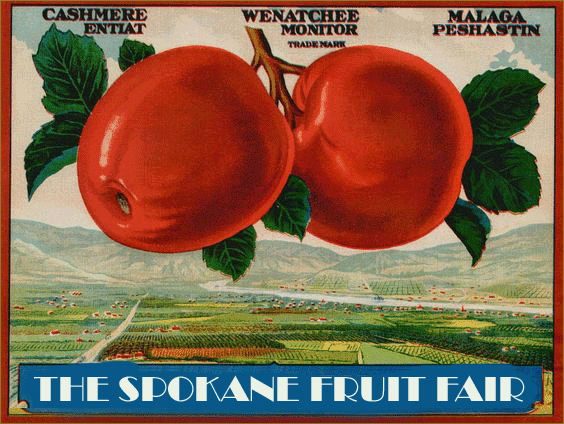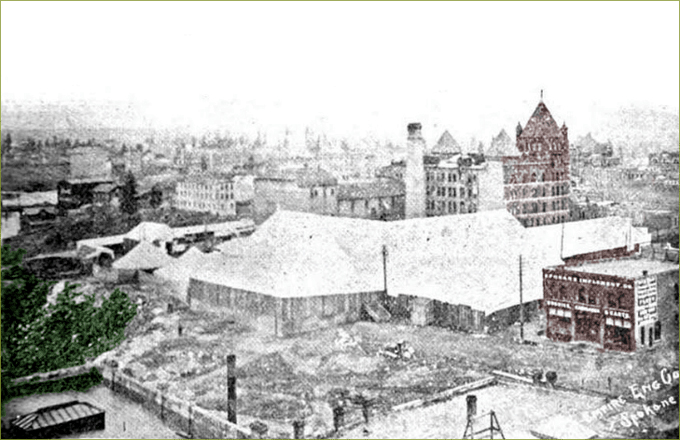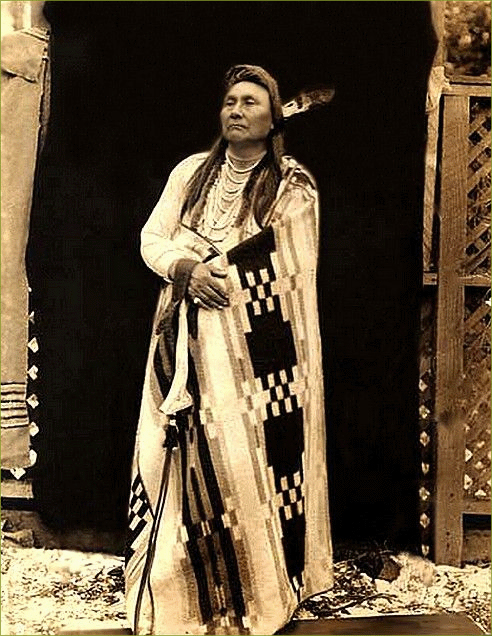

The Spokane Fruit Fair
BY: BG EDITOR

Feb 24, 2018 — GREENWOOD, BC (BG)
Starting in the late 1800s, the fair at Spokane was one of the major social events of the year taking place in the Pacific Northwest, and Greenwood was well represented there. The Spokane Fruit Fair drew visitors and participants from Greenwood who were not only interested in the region's agriculture, but also in its mining industry. The fair is described in the journal of the Northwest Mining Association:[1]
"For two or three years the Spokane Fruit Fairs, which were the predecessors of the Spokane Industrial Exposition, have put on mineral exhibits which have been good as far as they went, but which were far from representing the true importance of mining as an industry upon which the Inland Empire relies.
These mineral exhibits heretofore have been but a side issue. Pumpkins, potatoes, apples and pears were the chief attractions at the Fruit Fairs. These fairs did a great deal of good for these agricultural interests. They showed to the people of this part of the country what their soil was capable of producing, and they showed to the markets of America new sources of supplies in fruits and grains.
Now it is proposed by the exposition management to do as much, if not more, for the mining interests of the northwest. Mining is the industry which is making the Pacific northwestern states rich and prominent. At the present time at least, and probably it will be so always, mining is a more important industry in this part of the country than anything else. And as new mines develop and new districts and camps are discovered week after week, it is impossible to see how mining can lose its prestige. There seems little doubt that Spokane will soon rival Denver, as the greatest mining center in America."
These mineral exhibits heretofore have been but a side issue. Pumpkins, potatoes, apples and pears were the chief attractions at the Fruit Fairs. These fairs did a great deal of good for these agricultural interests. They showed to the people of this part of the country what their soil was capable of producing, and they showed to the markets of America new sources of supplies in fruits and grains.
Now it is proposed by the exposition management to do as much, if not more, for the mining interests of the northwest. Mining is the industry which is making the Pacific northwestern states rich and prominent. At the present time at least, and probably it will be so always, mining is a more important industry in this part of the country than anything else. And as new mines develop and new districts and camps are discovered week after week, it is impossible to see how mining can lose its prestige. There seems little doubt that Spokane will soon rival Denver, as the greatest mining center in America."
History of the Spokane Fruit Fair and Fairgrounds
In her book, The Fair Chronicles: 100 Years of Tradition, author Diane Nebel offers an extensive history of the Fruit Fair and subsequent regional fairs. She explains[2] that the fair started before Washington had even become a state. At that time, the event was billed as the Washington (territory) and Idaho Fair Association, in 1886,[3] and the fair was located at Corbin Park. It was held there for the next two years, until a huge fire in Spokane in 1889 cancelled the event. That was the year that Washington became a U.S. state.
In 1890, the fair became known as the Northwestern Industrial Exposition, and a Great Exhibition Hall was built between Sprague Avenue and Riverside Avenue. The next year the fair was billed as the Spokane Fair and Agricultural Association, and it ran by that name until 1894, when it became known as the Spokane Fruit Fair.
The Fruit Fair was run in a large agricultural implement warehouse on Riverside Avenue. In 1899 the hall location was moved to Lincoln and Post, near where the Spokane Public Library now stands. After that event, the name was changed again, to the Spokane Industrial Exposition. The Mining journal caption for the image below describes the scene:
"Birdseye view Spokane Fruit Fair Tent, 1898. Area of main tent, 54,000 square feet. Fruit Annex and Mining and Machinery Annex, 21,000 square feet. Total area, 75,000 square feet. The total area to be covered by the Spokane Industrial Exposition tents in 1899 will be approximately 125,000 square feet."

Birdseye view of Spokane Fruit Fair Tent, 1898
Mining: Journal of the Northwest Mining Association
[ Photo by Loryea, Spokane ]
In 1899, the Fair was famously visited by Chief Joseph. Diane Nebel's book, The Fair Chronicles: 100 Years of Tradition[4] describes the fascinating event that took place as part of the Fruit Fair. On October 6, 1899, the Nez Perce leader, Chief Joseph led a parade of about 1,000 braves, who processed down the streets of Spokane. Chief Joseph addressed the crowd, then performed a re-enactment of the great 1877 battle:
"Most American history books tell about the bloody Indian wars that took place in the 19th century. But few speak of the spectacular - and that's the only word for them - battles that regularly were waged between Nez Perce warriors and white soldiers and settlers as late as 1910. Onlookers would have seen something like this:
"With several hundred carbine rifles in the hands of both reds and whites splitting the night air in rapid succession and the constant heavy detonation of explosives representing General Howard's heavy artillery, the spirited scene roused the audience to a pitch of wild enthusiasm. Add to this the hideous war cries of the Indians, the flashing color of their gaily-colored blankets and the war drum's palpitating throb and a splendid panorama was presented."
"With several hundred carbine rifles in the hands of both reds and whites splitting the night air in rapid succession and the constant heavy detonation of explosives representing General Howard's heavy artillery, the spirited scene roused the audience to a pitch of wild enthusiasm. Add to this the hideous war cries of the Indians, the flashing color of their gaily-colored blankets and the war drum's palpitating throb and a splendid panorama was presented."

Chief Joseph of the Nez Perce
[ Photo: University of Washington ]
In 1901, the Fruit Fair committee came to an agreement with the State of Washington to buy new land for the event, being 60 acres situated in the 'Y' formed by two railroad tracks. The intent was for an event that would be "a county fair, with horse racing, stock exhibits, with all the other features of such an exhibition."[5]
Greenwood's Participation in the Spokane Fruit Fair
Two years after it became known as the Spokane Fruit Fair, the local mining men of Greenwood and vicinity got involved in exhibiting their mineral samples. It seems that the first year of organizing the effort didn't go entirely smoothly, and the editor of the Boundary Creek Times had to get involved, applying a little pressure of 'social conscience', which succeeded. But as we will see in part two of this series, in later years, Greenwood's enthusiasm for participating in the Fruit Fair grew tremendously. Following are the calls for entries that year.
From the Boundary Creek Times, September 19, 1896:[6]
"Mr. J. C. Haas, as vice-president for this district of the North-west Miners' Association, is making praiseworthy efforts to obtain a representative exhibit of ores from the different Boundary camps, to show at the Spokane Fruit Fair, which is to be held in the early part of October. We regret to say that Mr. Haas has not received from some quarters the encouragement which should be shown him; and that his motives, which to any sensible individual must appear disinterested, are attributed to a desire to further his personal interests. The question is, are the miners and prospectors of Boundary going to allow this excellent opportunity of advertising the country to pass by?
The Grand Forks people have long ago recognized the importance of making an exhibit of rock from claims in their part of the district, and a good collection of ores from Summit camp, Grand Prairie, Brown's camp and from the North Fork has already accumulated. There is yet a week or ten days left in which to make a collection from Boundary. The Times has been asked to request men owning representative claims in any of the surrounding camps to bring down to Greenwood 25 or 50 pounds of sample rock, where it will be taken care of until the time arrives for shipment. In all about a ton of specimen ore is to be sent.
The Association pay all expenses of transportation from Marcus to Spokane, and a subscription list will be opened here to defray the cost of freighting from Boundary to the railway. About fifty dollars will be required."
The Grand Forks people have long ago recognized the importance of making an exhibit of rock from claims in their part of the district, and a good collection of ores from Summit camp, Grand Prairie, Brown's camp and from the North Fork has already accumulated. There is yet a week or ten days left in which to make a collection from Boundary. The Times has been asked to request men owning representative claims in any of the surrounding camps to bring down to Greenwood 25 or 50 pounds of sample rock, where it will be taken care of until the time arrives for shipment. In all about a ton of specimen ore is to be sent.
The Association pay all expenses of transportation from Marcus to Spokane, and a subscription list will be opened here to defray the cost of freighting from Boundary to the railway. About fifty dollars will be required."
And a week later in the Times:[7]
THE MINERAL EXHIBITION.
"Thanks to Mr. Haas' energy and the co-operation of a few others, a fairly representative exhibit of Boundary Creek ores will be on view at the Spokane Fruit Fair. Samples of rock from the following claims are to be shipped to Marcus to-day:
From Greenwood camp — Stemwinder, Gold Drop, Rawhide, Snowshoe, Knob Hill, Standard and Brooklyn; from Wellington camp — Winnipeg, Golden Crown and Calumet; from Summit camp — Emma and R. Bell; from White's camp — City of Paris, Lincoln, Jack of Spades, Lexington, Excelsior and No. 7; from Skylark camp — Skylark, Crescent, Canadian and Tip Top; from Long Lake camp — Jewel and Denoro Grande; from Smith's camp — Non Such, Last Chance, Republic, Great Hesper, Boundary Falls and Golconda; from Deadwood camp — Great Hopes, Hidden Treasure, Gold Bug, Ira Lenora and Mother Lode; from Copper camp — Copper; from Graham's camp — Texas and Bruce; Providence camp — Combination and D.A.
About a hundred pounds of coal from Rock Creek will also be placed on exhibition. It is to be regretted that to the indifference of many claim owners is attributable a much more limited collection being sent to Spokane for exhibition purposes than might otherwise well have been the case. To some men, unless the possibility of a direct personal gain is clear, no action appears desirable. It is unfortunate that a way of preventing this class from sharing in the general good certain to accrue from so efficient a plan of advertising the district, is not devisable."
"Thanks to Mr. Haas' energy and the co-operation of a few others, a fairly representative exhibit of Boundary Creek ores will be on view at the Spokane Fruit Fair. Samples of rock from the following claims are to be shipped to Marcus to-day:
From Greenwood camp — Stemwinder, Gold Drop, Rawhide, Snowshoe, Knob Hill, Standard and Brooklyn; from Wellington camp — Winnipeg, Golden Crown and Calumet; from Summit camp — Emma and R. Bell; from White's camp — City of Paris, Lincoln, Jack of Spades, Lexington, Excelsior and No. 7; from Skylark camp — Skylark, Crescent, Canadian and Tip Top; from Long Lake camp — Jewel and Denoro Grande; from Smith's camp — Non Such, Last Chance, Republic, Great Hesper, Boundary Falls and Golconda; from Deadwood camp — Great Hopes, Hidden Treasure, Gold Bug, Ira Lenora and Mother Lode; from Copper camp — Copper; from Graham's camp — Texas and Bruce; Providence camp — Combination and D.A.
About a hundred pounds of coal from Rock Creek will also be placed on exhibition. It is to be regretted that to the indifference of many claim owners is attributable a much more limited collection being sent to Spokane for exhibition purposes than might otherwise well have been the case. To some men, unless the possibility of a direct personal gain is clear, no action appears desirable. It is unfortunate that a way of preventing this class from sharing in the general good certain to accrue from so efficient a plan of advertising the district, is not devisable."
By October 10th, mineral samples had been delivered, and the social page announced the opening of the fair:[8]
"The Spokane Fruit Fair was opened on Tuesday by Mr. John A. Finch, the well-known mine owner, who delivered a very felicitous address of welcome to the visitors.
Mr. J. McNicol left for Spokane on Wednesday, and Messrs. J. Franks and Fisher on Thursday. They will be among the visitors from Boundary to the Fruit Fair."
Mr. J. McNicol left for Spokane on Wednesday, and Messrs. J. Franks and Fisher on Thursday. They will be among the visitors from Boundary to the Fruit Fair."
In our next segment, we'll talk about the detailed arrangements made for displaying mining samples in the great exhibit halls, and the many ways in which Greenwood and our local mining camps helped to draw attention to the riches of the Boundary region.
(To be continued…)
FOOTNOTES:
[1] "The Spokane Industrial Exposition" - Mining: Journal of the Northwest Mining Association, Volumes 4-7, pp. 23-28
https://tinyurl.com/y73g24nx
[2] "A Fair to Remember…"
http://www.spokesman.com/stories/1997/feb/25/a-fair-to-remember-in-one-form-or-another-the/
[3] 1800s History of the Spokane Fair
http://www.spokanecounty.org/1124/History-During-the-1800s
[4] The Fair Chronicles: 100 Years of Tradition by Diane Nebel
[5] The History of Playfair Commerce Park
http://playfaircp.com/history/
[6] Boundary Creek Times — Sep 19, 1896, p. 6
https://open.library.ubc.ca/collections/bcnewspapers/xboundarycr/items/1.0170724
[7] Boundary Creek Times — Sep 26, 1896, p. 2
https://open.library.ubc.ca/collections/bcnewspapers/xboundarycr/items/1.0170726
[8] Boundary Creek Times — Oct 10, 1896, p. 3
https://open.library.ubc.ca/collections/bcnewspapers/xboundarycr/items/1.0170618


